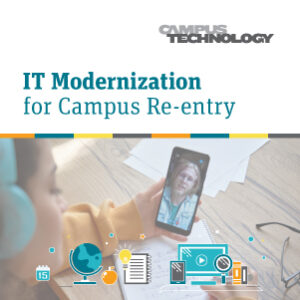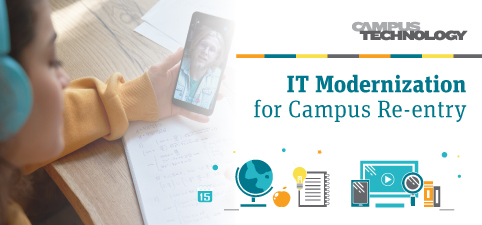Many colleges and universities are poised to emerge from the pandemic stronger than they went in. In large part, they have used the last year to accelerate their adoption of online education where it makes sense, keeping the physical classroom time dedicated to experiential forms of learning. A theme among these institutions is the need to understand what the IT infrastructure can support and how well it’s holding up as institutional demands ebb and flow. A Campus Technology “pulse survey” among IT leaders and professionals found that while the impact of remote learning and work made their jobs harder rather than easier (by 11 percentage points), the outcomes have been worth the effort. Four times as many participants agreed than disagreed that their organization’s response to the pandemic was improving the way they deliver services to students, faculty and staff. Learn how your institution can continue to adapt IT infrastructure in Carahsoft’s Innovation in Education report.
Mastering the Art and Design of Remote Work
“On a traditional physical computing device like a workstation, PC or laptop, a GPU typically performs all the capture, encode and rendering for power complex tasks, such as 3D apps and video. NVIDIA virtual GPU technology virtualizes GPUs installed in the data center to be shared across multiple virtual machines or users. The rendering and encoding are done on the virtual machines’ host server rather than on a physical endpoint device. The basic idea is to share the GPU functionality with multiple users and give them the same experience as they’d have if they were running applications on dedicated workstations. The advantage is this: Instead of having a one-to-one connection — one GPU per computer — you get one-to-many. The physical GPU runs in a server and the vGPU software dynamically slices it up to allow multiple users to access its power (up to as many as 64 users per GPU).”
Read more insights from NVIDIA’s Senior Product Specialist, Ismet Nesicolaci.
Easier Identity and Access Management
“Single sign-on (SSO) has long been a boon for making the authentication process more efficient. Yet, because of their distributed structures, most institutions haven’t gone all the way with SSO. It may be that program control for the identity and access management (IAM) layer is maintained for some applications by central IT and for others by a given college or department. IT may lack the staff to keep up with the programming requirements and/or the sudden influx of new demand. Or the college or university may be working with other institutions, each operating autonomously even as they need to share people, programs and research data. Then there are the security aspects. While SSO makes for a centralized approach to application access, that access also poses a big risk: If a cybercriminal gets unauthorized access through the SSO, they will be able to access all of the associated applications. Embedding multi-factor authentication (MFA) into the login process adds a needed level of protection to authentication processes to keep accounts truly secure. But students are still stuck with multiple logins, and institutions have to try to keep up with a sprawling and complicated IAM system.”
Read more insights from Okta’s Senior CIAM Developer Specialist, Ryan Schaller.
Evolving with IT to Support Research
 “While institutions have expressed continuing concern about wobbling tuition and ancillary dollars, one source of revenue remains healthy for higher education: COVID-19 research funded by federal and state programs. The full measure, from community colleges to Research 1s, are at the forefront of projects to develop vaccines; uncover the sources of coronavirus and its evolving replication patterns; create new initiatives for public health response; understand the impact of the virus on various populations; study the physical and mental health and learning effects of prolonged quarantine; and explore numerous other facets.. However, the heightened attention on campus research comes with a continuing challenge: how to keep up with IT infrastructure needs, typically assembled once the grant funding arrives. Since many of these recent grants are shortterm, turnaround time can be tight. In many cases, research teams are going from near-zero infrastructure to running as quickly as possible — and not just serving applications to users, but storing, processing and sharing astronomical amounts of data.”
“While institutions have expressed continuing concern about wobbling tuition and ancillary dollars, one source of revenue remains healthy for higher education: COVID-19 research funded by federal and state programs. The full measure, from community colleges to Research 1s, are at the forefront of projects to develop vaccines; uncover the sources of coronavirus and its evolving replication patterns; create new initiatives for public health response; understand the impact of the virus on various populations; study the physical and mental health and learning effects of prolonged quarantine; and explore numerous other facets.. However, the heightened attention on campus research comes with a continuing challenge: how to keep up with IT infrastructure needs, typically assembled once the grant funding arrives. Since many of these recent grants are shortterm, turnaround time can be tight. In many cases, research teams are going from near-zero infrastructure to running as quickly as possible — and not just serving applications to users, but storing, processing and sharing astronomical amounts of data.”
Read more insights from Red Hat’s Chief Architect for Higher Education for the North America Public Sector, Damien Eversmann.
Your Starting Point for IT Optimization
“The university IT shop doesn’t typically head to Best Buy when it’s time to update infrastructure. Acquisitions have to go through internal planning and approval, budgeting and ordering — and it all takes time. Having visibility into usage trends enables the IT department to better plan, thereby preventing gaps in performance and operations and opening up ample time to line up the funding needed. Best-of-breed monitoring takes that a step further, pulling in information from outside sources, so the IT crew doesn’t have to wonder. SolarWinds Network Configuration Manager, for example, links up with the relevant hardware and software to notify you when a vendor has put an end-of-support notice out. If Cisco has issued an end-of-of life message for a given switch, it serves as an early indicator for you to help plan timing of replacement.”
Read more insights from SolarWinds’ Vice President of Product Strategy for Security for Compliance and Tools, Brandon Shopp.
Building the Virtualized Student Union
“The IT organization has been at the heart of successful pivoting as remote teaching and learning have dominated. As a result, now that campuses are starting to return to normalcy, administration will rely on IT to continue enabling the work of enhancing the student experience. That’s especially true if, as many experts predict, hybrid or blended learning will forevermore be part of the modernized college experience. Integration is a big part of the solution. Forget about forcing students to figure out the dozens of different apps and websites they need to fully partake of college. IT needs to integrate the learning management platform, digital content, student support services, health and wellness, esports, collaboration, campus calendar and student information — enfolding them into a virtual student union. This idea goes beyond the student portal, which has been around for a long time. What’s new is the idea of marrying systems that may be PC-based, on-premise-based and cloud-based into a single hub and then wrapping that in a blanket of security that’s transparent to the user. That becomes a game-changer for the student experience.”
Read more insights from VMware’s SLED Strategist, Herb Thompson; VP of State, Local, and Education, Doug Harvey; and Senior National Director for SLED Business Development, John Punzak.
Accelerating Student Success with AI
“As growth in undergraduate credential earning has come to a standstill over the last year, colleges and universities are seeking new ways to draw in the right candidates while also holding onto the students they have by bolstering student success efforts. Numerous institutions of higher education are finding success in strategic aspects of the academic lifecycle by embedding the use of artificial intelligence and machine learning. There are several areas where Google sees the potential for “quick wins” in student success initiatives: optimized enrollment and admission, such as automating the activities of credit transfer analysis, document analysis and personalized course planning; virtual assistance, for delivering 24/7 online tutoring and support in multiple languages answering common questions about required courses, financial aid and other topical subjects; and student engagement, like tracking engagement and predicting which students are at risk, to maximize retention.”
Read more insights from Google Cloud’s Cloud Strategic Business Executive for Higher Education and Research, Jesus Trujillo Gomez.
A Conversation with Jen Leasure
“As everything went online and was done with technology, institutions needed to invest in new solutions to support their researchers, their faculty, their students, their administration, in conducting their business — and with limited budgets. We know that everyone’s been having particular budget constraints, and they’re looking to maximize the benefits of these types of programs and their discounts. This type of program has been especially important during COVID. And remote and hybrid learning isn’t going away, as we know. It’s difficult to foresee a world where hybrid becomes an option instead of a requirement. Folks don’t like options taken away once they’re there. And so, the investment in these types of solutions is going to continue to support future directions. Cloud access especially has become important for institutions to support their students. That’s one area where we have seen a lot of growth in the last year.”
Read more insights from The Quilt’s President and CEO, Jen Leasure.
Download the full Innovation in Education report for more insights from these thought leaders and additional industry research from Campus Technology.








